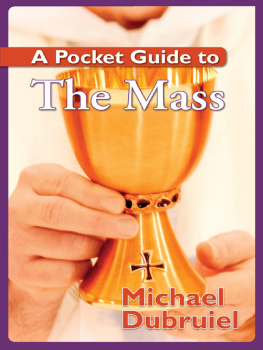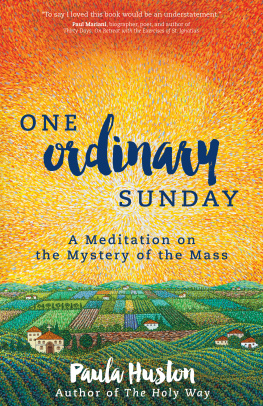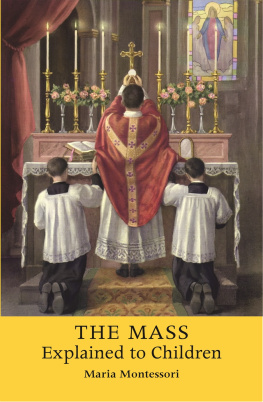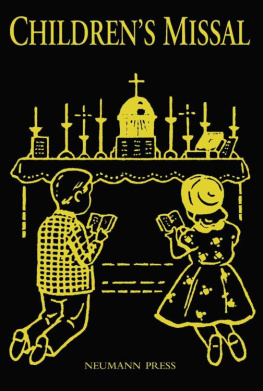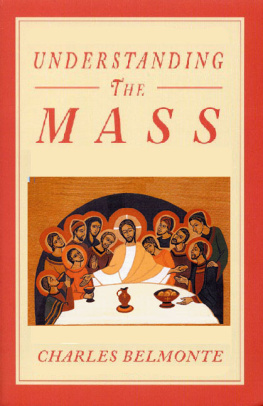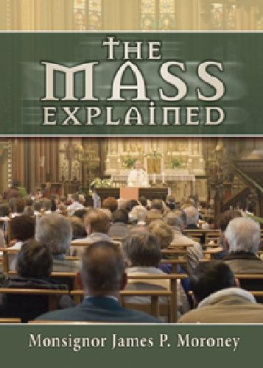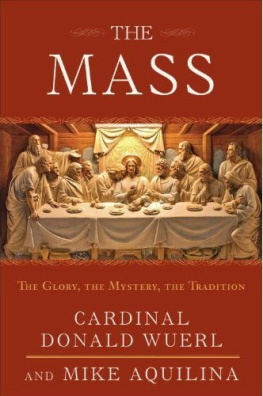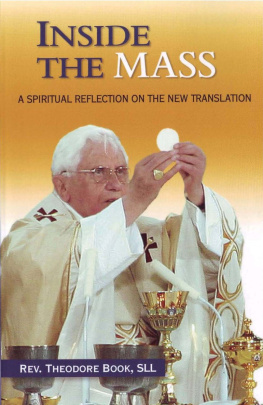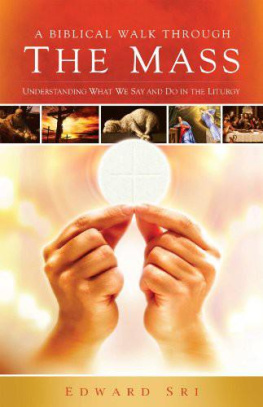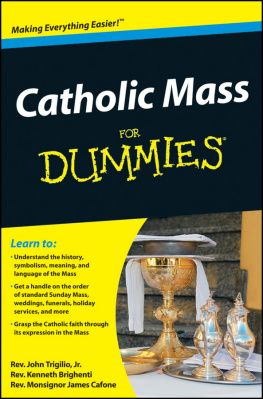Loving and Living the Mass
Second Edition
Fr. Thomas Kocik
Zaccheus Press
Bethesda
Nihil Obstat:
Rev. Mark Knestout
Censor Deputatus
Imprimatur:
Most Reverend Barry C. Knestout
Auxiliary Bishop of Washington
Archdiocese of Washington
August 18, 2011
Loving and Living the Mass, Second Edition. Copyright 2007, 2011 by Thomas Kocik. Cover design copyright 2007, 2011 by Zaccheus Press. All rights reserved. No part of this book may be used or reproduced in any manner whatsoever without written permission except in the case of quotations in critical articles or reviews. For information address: comments@zaccheuspress.com.
Zaccheus Press and the colophon are trademarks of Zaccheus Press.
Library of Congress Cataloging-in-Publication Data (Print Edition)
Kocik, Thomas M.
Loving and living the Mass / Thomas Kocik. -- 2nd ed. p. cm.
Includes bibliographical references.
ISBN 978-0-9830297-3-1
1. Mass. I. Title.
BX2230.3.K63 2011
264'.36--dc23
2011034589
Pater Misericordiae, emitte Spiritum Tuum ut omnium hunc librum legentium et mentum illuminet et cor tangat. Sit instrumentum ad exaedificandum Regnum Tuum. Per Christum Dominum nostrum. Amen.
Visit our webpage to learn more:
www.zaccheuspress.com
Dedication
To my parents,
Thomas and Dorothy,
my first teachers
in the central lesson
of the Holy Mass:
sacrificial love
Table of Contents
Preface to the Second Edition
PART ONE
PRELIMINARIES
Introduction
What is the Mass?
Outline of the Mass
A Look Inside the Church
The Tools of the Trade: Sacred Vessels and Other Items
Dressing Accordingly: Sacred Vestments
The Body Language of the Mass: Postures and Gestures
Why Ritual Worship?
PART TWO
A TOUR OF THE MASS
The Introductory Rites
The Liturgy of the Word
The Liturgy of the Eucharist
A Prayer to Live the Mass
APPENDIX
Why a New English Translation of the Mass?
Works Consulted & Further Study
About the Author
Preface
This book originated as a weekly series in The Anchor , the official newspaper of the Diocese of Fall River, Massachusetts. I thank Father Roger J. Landry, the executive editor, for inviting me to contribute the series and for encouraging me to have it published in a single volume. I am likewise grateful to Zaccheus Press for publishing my work.
Inserting into the original work my reference for every statement concerning the prayers, ceremonies, and theology of the Mass would encumber the text and unduly distract the non-specialist for whom it was written. Therefore, to maintain the originals informality and broad appeal, I have added footnotes sparingly. In the same vein, I have given the English titles of the few patristic writings cited, even when the secondary source bears the Latin title. The Bibliography lists the chief sources used in writing this book as well as other works for those readers interested in further study.
The official Latin text of the Mass is contained in a book known as the Missale Romanum (Roman Missal). In 1970, a few years after the close of the Second Vatican Council, Pope Paul VI published a new edition of the Roman Missal in Latin. Some parts of the new Missal appeared in English straightaway, although the first official English translation in its entirety dates to 1973. In 2010, the Holy See approved the final portions of a revised English translation of the Missal of Paul VI in its most recent edition, the one published in 2002. This second edition of Loving and Living the Mass , revised in the light of the new English translation, includes a new chapter explaining why and how the new translation came about, as well as a new chapter on the importance of ritual in human life and divine worship.
The Order of Mass described herein conforms to the third edition of the Roman Missal (2002). Excerpts from the revised English translation are as found in The Roman Missal, Third Edition (United States Conference of Catholic Bishops, 2010), prepared by the International Commission on English in the Liturgy (ICEL). Biblical quotations are from the Revised Standard Version (RSV)Catholic Edition.
T.K.
Fall River, Mass.
Loving and Living the Mass
Second Edition
PART ONE
PRELIMINARIES
Introduction
Do you enjoy going to Mass? (Be honest.) You may be a very good Catholic and still feel that Mass attendance is something of a chore having little to do with real life. Many Catholics go to Mass every Sunday or Saturday evening because it would be a serious offense against God not to, or because they have become so used to going every week that it has become mechanical. These reasons are good enough as far as they go, since the primary purpose of the Mass is not to please us but to worship our Creator. Still, if your fidelity to Sunday Mass rests on nothing more solid, your attitude at Mass is likely to be nothing more than penitential obedience. If you really understand what is happening at Mass and how the Mass should impact your life, youll find Mass anything but boring. This book is meant to help you deepen your appreciation of the Catholic Churchs supreme act of worship, and to live the meaning of the Mass in your daily life. We will walk through the Mass from its beginning to end, exploring the significance of its various prayers, symbols and gestures. Before we begin our tour of the Mass, however, some background information will be helpful.
Lets start with the word Mass. In the early centuries of Christianity the Mass was known by other names, such as the Breaking of Bread, the Eucharist, and the Lords Supper. The name Mass was not used until many years later (and only in the Western or Latin Church) when the custom began for the deacon to dismiss the people formally from the service. Go, it is the dismissal, he said. The phrase in Latin is Ite, missa est. And missa, dismissal, is in English Mass. Eastern Christians, both Orthodox and Catholic, refer to the Mass as the Divine Liturgy. Whatever the name used, the Mass is the Churchs obedient response to Jesus command at the Last Supper: Do this in remembrance of me (Lk 22:19).
What, in fact, we are doing and what, if anything, Christ is doing in our doing of it will be explained in the next chapter. Then we will look at a broad outline of the Mass and what happens in each section. As further preparation for our tour, we will survey the inside of a typical Roman Catholic church and note the sacred vessels, vestments, and other items used to celebrate the Eucharist. The preliminaries conclude with an explanation of both the body language of the Mass, meaning the postures and gestures Catholics use in worshiping God, and the necessity of formal ceremonial. By then, we should be well prepared to begin our tour.
Dont worry about remembering everything. After all, the apostles didnt fully understand all that was happening at the Last Supper. They were told only that the bread which Jesus broke was no longer bread but His actual Body, and that the wine in the cup was no longer wine but His Blood. Accepting this mystery of faith, the apostles understood enough to make them active participants in our Lords act. They were sharing in what was, with the crucifixion that was to take place the next day, the first Mass. So you dont have to be a theologian to get something out of the Mass, or to put your best into it. Of course, the more you know about the Mass, the better you can appreciate its indispensable role in your spiritual life. A wise monk once remarked that for a Catholic to become holy without the Mass would be as impossible as for a Catholic who loved the Mass not to become holy. Before you turn the page, think that one out.


